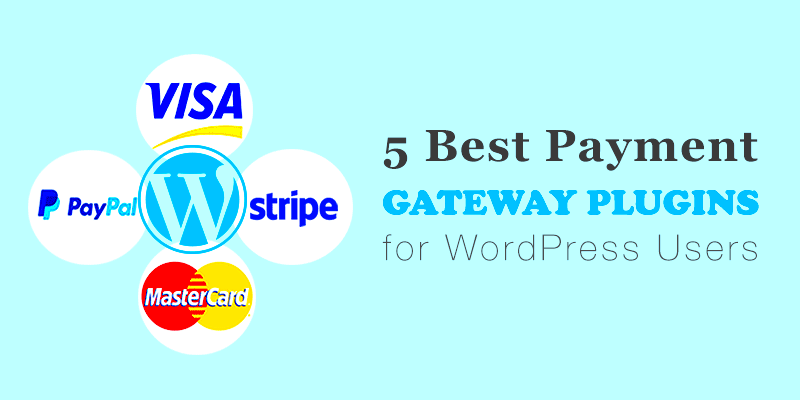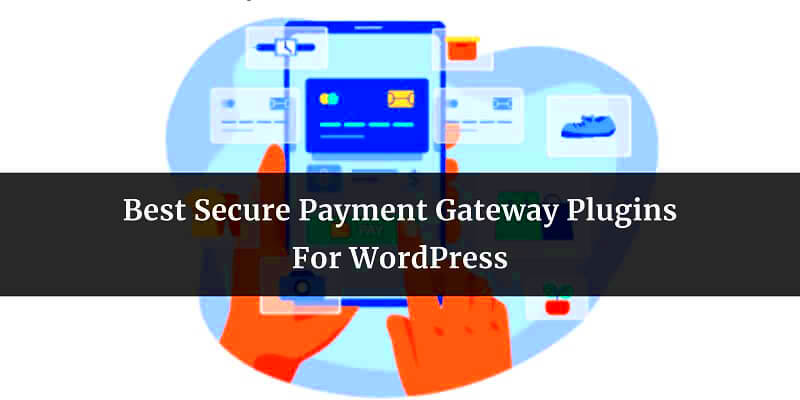In today’s digital age, having a robust online presence is crucial for businesses of all types. One of the key components that empower e-commerce websites is the use of WordPress payment plugins. These plugins facilitate seamless transactions, allowing customers to make purchases effortlessly. With the wide array of options available, you can integrate secure payment methods right into your WordPress site. From credit cards to PayPal and even cryptocurrencies, these tools make it easier than ever to manage your online sales efficiently.
Importance of Secure Transactions in E-Commerce

When it comes to online shopping, security is not just an option—it’s a necessity. Let’s dive into why secure transactions should be a top priority for any e-commerce business.
- Building Trust: Customers are unlikely to complete a purchase if they feel that their personal information is at risk. A secure payment gateway instills confidence, encouraging shoppers to finalize their transactions.
- Preventing Fraud: E-commerce stores are prime targets for fraudsters. Implementing robust security measures helps protect both the business and the customers from potential scams and financial loss.
- Compliance with Regulations: Many countries have strict laws regarding online transactions, like the General Data Protection Regulation (GDPR) in Europe. Ensuring secure payment processes helps businesses comply with such regulations, avoiding hefty fines.
- Customer Retention: Security lapses can lead to data breaches, which often damage a company’s reputation. By prioritizing secure transactions, businesses can foster long-term loyalty among customers.
In summary, secure transactions are vital for the successful operation of any e-commerce website. By integrating dependable WordPress payment plugins, you not only protect your business but also create a safe shopping environment for your customers.
Top WordPress Payment Plugins Overview
When it comes to setting up payment gateways on your WordPress site, choosing the right plugin can make all the difference. With various options available, how do you know which one to select? Let’s explore some of the top WordPress payment plugins that have garnered acclaim and can elevate your online transactions.
- WooCommerce Payments: This is a popular choice among eCommerce site owners. Seamlessly integrated with WooCommerce, it allows you to manage payments directly from your WordPress dashboard. Its benefits include ease of use and direct integration with other WooCommerce features.
- Stripe for WooCommerce: Known for its robust security and versatile payment options, Stripe allows you to accept credit cards and various other payment methods. Its compatibility with WooCommerce makes it an excellent option if you’re already using this platform.
- PayPal Checkout: With its worldwide recognition, PayPal offers an easy and trustworthy way for customers to make payments. This plugin allows for quick installation and provides various payment options like credit cards and PayPal balance.
- WP Simple Pay: If you’re not running a full eCommerce site but need to accept payments, WP Simple Pay is a great choice. It simplifies the payment process without requiring an entire shopping cart, which suits service-oriented websites perfectly.
- Authorize.Net: For businesses that need a reliable, scalable solution, Authorize.Net provides a powerful suite of tools for managing online transactions. This plugin is ideal for businesses that process a high volume of transactions.
Making the right choice depends on your specific business needs. Always consider factors like ease of use, compatibility, and transaction fees when deciding on a payment plugin for your WordPress site.
Features to Look for in Payment Plugins
Selecting the right payment plugin for your WordPress site is crucial for ensuring secure transactions and a smooth user experience. With so many options available, what features should you be looking for? Let’s break it down.
| Feature | Description |
|---|---|
| Security Measures | Look for plugins that offer robust security features, like SSL encryption and PCI compliance. This is essential for safeguarding your customers’ data. |
| Multiple Payment Options | A good plugin should allow customers to pay using various methods, including credit/debit cards, PayPal, and digital wallets, making transactions convenient. |
| User-Friendly Interface | The plugin should be easy to navigate for both you and your customers. A simple and intuitive interface can drastically improve the user experience. |
| Integration Capabilities | Make sure the plugin seamlessly integrates with your existing systems, like inventory management and accounting software. |
| Transaction Fees | Be aware of the transaction fees associated with each payment option. Some plugins have higher fees, which can cut into your profit margins. |
| Customer Support | Ensure that the plugin provides reliable customer support in case you encounter problems. Good support can save you time and headaches. |
In conclusion, picking the right payment plugin lies in understanding your business needs and evaluating essential features. Prioritize security, user experience, and integrations to ensure smooth transactions for both you and your customers.
How to Choose the Right Payment Plugin for Your Website
Choosing the right payment plugin for your WordPress website can feel overwhelming with so many options available. But don’t worry! I’ve got your back. Here are some guidelines to help you make the best choice:
- Identify Your Needs: What kind of products or services do you offer? Are you selling physical goods, digital downloads, or subscriptions? Your choice should align with your business model. For instance, if you sell subscriptions, look for plugins that support recurring payments.
- Payment Methods: Does the plugin support the payment methods your customers prefer? Options like credit cards, PayPal, Stripe, and local payment gateways can significantly affect user experience. Ensure that the plugin accommodates a range of payment methods.
- Transaction Fees: Always check the fee structure of the payment processor associated with the plugin. Some may charge a percentage of each transaction, which can add up over time, especially for small businesses.
- Security Features: Security is a top priority. Look for plugins that comply with PCI DSS standards and offer features like SSL integration, tokenization, and fraud detection. This ensures that customer data is safe and transactions are secure.
- Customer Support: Consider the level of support available. Is there documentation, FAQs, or a support team you can reach out to? Reliable customer support can save you from potential headaches down the line.
- User Reviews: Lastly, go through user reviews and ratings. This gives you a real-world perspective on the plugin’s performance and reliability, helping you make an informed decision.
By considering these factors, you’ll be well on your way to selecting the perfect payment plugin that meets the unique needs of your website!
Integrating Payment Plugins with Your WordPress Site
Once you’ve chosen the right payment plugin, the next step is integrating it with your WordPress website seamlessly. Don’t fret; the process is generally straightforward! Let’s walk through it step by step:
- Install the Plugin: Start by navigating to your WordPress dashboard. Go to Plugins > Add New and search for your chosen payment plugin. Click Install Now, then activate the plugin.
- Configure Settings: After activation, you’ll usually find a new menu on your dashboard. Click on it to access the settings. Here, you can configure essential details like payment gateways, currencies, and tax settings.
- Set Up Payment Credentials: Most payment plugins will ask for API keys or other credentials from their respective payment gateways (like PayPal, Stripe, etc.). You can obtain these from your payment provider’s dashboard. Input these keys in the designated fields within the plugin settings.
- Customize the Checkout Experience: Many plugins allow you to customize the design and flow of the checkout page. This is an excellent opportunity to align it with your site’s branding. Make sure it’s user-friendly, too!
- Test Transactions: Before going live, always run tests to ensure that everything works smoothly. Most plugins offer a ‘sandbox’ mode where you can simulate transactions without real money involved. Use this feature to catch any hiccups!
- Go Live! Once you’re satisfied with the test results, switch to live mode. Inform your customers about the new payment options and ensure your site’s payment section is easy to find.
Integrating payment plugins doesn’t have to be a daunting task. With these steps, you’ll be accepting payments on your WordPress site in no time. Happy selling!
7. Best Practices for Ensuring Transaction Security
When it comes to online transactions, security should always be a top priority. Implementing best practices can significantly reduce the risk of fraud and enhance the safety of your customers’ sensitive information. Let’s dive into some of these practices to ensure secure transactions on your WordPress site.
- Use HTTPS: Ensure your website is secured with an SSL certificate. This encrypts data transferred between your site and the user, making it much harder for eavesdroppers to intercept sensitive information.
- Regularly Update Plugins and Themes: Outdated plugins and themes can have security holes. It’s vital to keep your WordPress installation, themes, and plugins updated to their latest versions.
- Choose Reliable Payment Plugins: Not all payment plugins are created equal. Opt for well-reviewed, reputable plugins that prioritize security. Look for those that comply with Payment Card Industry Data Security Standard (PCI DSS) requirements.
- Implement Strong Password Policies: Encourage your users to create strong passwords. Use a combination of uppercase letters, lowercase letters, numbers, and special characters. Consider implementing two-factor authentication for an added layer of security.
- Regular Backups: Regularly back up your website and transaction data. This ensures you can restore your site in case of any security breaches or data loss.
- Monitor Transactions: Keep an eye on transactions for any suspicious activity. Set up alerts for unusual transactions, and promptly address any anomalies.
- Educate Yourself and Your Team: Stay informed on the latest security threats and best practices. Regular training can help your team identify and prevent potential security risks.
By following these best practices, you can create a secure environment that not only protects your business but also gives your customers confidence in their transactions.
User Experience and Customer Confidence
In today’s fast-paced online world, user experience (UX) is crucial, especially when it comes to financial transactions. The way you design and implement your payment processes can significantly impact customer confidence. Let’s explore how a well-thought-out user experience can enhance customer trust in your payment system.
- Simplified Checkout Process: A complicated checkout process can frustrate customers and lead to cart abandonment. Streamline your checkout by minimizing the number of steps, allowing guest checkouts, and pre-filling information where possible.
- Clear Payment Options: Make sure your payment options are displayed clearly. Offering various payment methods, including credit cards, PayPal, and other digital wallets, caters to different preferences and builds trust.
- Trust Signals: Incorporate trust signals like security badges, customer reviews, and payment acceptance logos. These elements reassure customers that their information is secure and that you’re a legitimate business.
- Responsive Design: Ensure your payment interface works across all devices – desktops, tablets, and mobile phones. A responsive design improves user experience and is essential as more consumers shop on mobile devices.
- Transparent Pricing: Be upfront about any additional fees or costs involved in the transaction. Hidden fees can create a sense of distrust and lead to cart abandonment.
- Clear Communication: When a transaction is being processed, provide clear communication. Let users know the status of their transactions and if there are any issues.
Ultimately, an excellent user experience cultivates customer confidence. Remember, happy customers are more likely to return and recommend your services to others!
WordPress Payment Plugins for Secure Transactions
In today’s digital marketplace, ensuring secure transactions is critical for any e-commerce business. WordPress, being one of the most popular content management systems, offers a wide range of payment plugins to help online merchants facilitate safe and efficient payment processing. Here are some of the top choices:
- WooCommerce Payments
This built-in solution offers seamless integration with WooCommerce, enabling users to manage payments directly from their WordPress dashboard.
- Stripe for WooCommerce
This plugin allows users to accept credit card payments directly on their site, reducing cart abandonment caused by redirects.
- PayPal for WooCommerce
Integrating PayPal allows customers to pay with their PayPal account or credit card securely, enhancing user trust during the checkout process.
- Square for WooCommerce
This plugin offers versatile payment options, including in-person transactions, which is excellent for businesses with both online and offline presence.
- Authorize.Net
A reliable option that offers extensive fraud prevention tools, making it suitable for businesses prioritizing security.
| Plugin | Key Feature | Security Level |
|---|---|---|
| WooCommerce Payments | Integrated management | High |
| Stripe | Direct credit card payments | High |
| PayPal | Trusted payment options | High |
| Square | In-person & online integration | Medium |
| Authorize.Net | Fraud prevention tools | High |
Making informed choices about which payment plugins to implement in your WordPress e-commerce site is crucial. By evaluating their features and security measures, you can select solutions that enhance customer trust, streamline transactions, and protect sensitive financial information.



